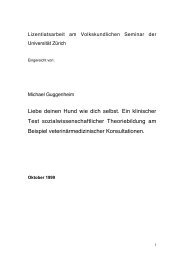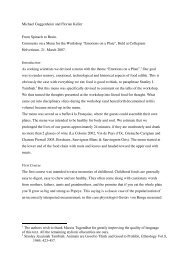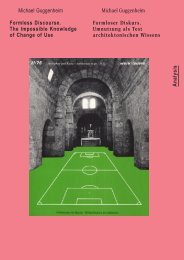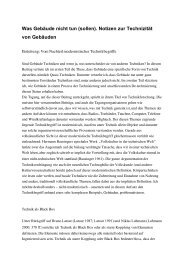The Laws of Foreign Buildings: Flat Roofs and Minarets - Michael ...
The Laws of Foreign Buildings: Flat Roofs and Minarets - Michael ...
The Laws of Foreign Buildings: Flat Roofs and Minarets - Michael ...
You also want an ePaper? Increase the reach of your titles
YUMPU automatically turns print PDFs into web optimized ePapers that Google loves.
Guggenheim 15<br />
For the Muslim community <strong>and</strong> also for the Cantonal court, the building type is<br />
defined by its use. <strong>The</strong> factory building is already a mosque even before a minaret is<br />
added. <strong>The</strong>ir position is strictly socializing the building. <strong>The</strong> minaret itself is only ‘symbolic’<br />
because it cannot be used to call for prayer. <strong>The</strong> minaret does not define the building<br />
type hence they materialize it. In a second step, the campaign to ban minarets follows<br />
this materializing move, by acknowledging that the minaret is only symbolic <strong>and</strong> does<br />
not define the building type, which is exactly the reason why the initiative supposedly<br />
does not violate religious freedom. For the committee, the minaret has been represented<br />
as a political symbol for the anti-democratic tendencies <strong>of</strong> Islam, <strong>and</strong> is not necessary for<br />
the exercise <strong>of</strong> Islamic religion. <strong>The</strong> initiative, if passed, would not stop the building <strong>of</strong><br />
mosques defined as prayer spaces without minarets. It would prove that minarets are not<br />
technological requirements for the religious use <strong>of</strong> the building. But then the webpage<br />
also states that the spread <strong>of</strong> Islam should be stopped with the help <strong>of</strong> the initiative. This<br />
implicitly assumes that if mosques did not have minarets they would be less useful in<br />
spreading the message <strong>of</strong> Islam. <strong>The</strong>reby they mediatize the minaret, not with reference<br />
to religion, but to politics.<br />
If we ask whether the law prohibits the immigration <strong>of</strong> building types, an irritating<br />
answer emerges: the initiative has been passed, but Switzerl<strong>and</strong> will most likely not prevent<br />
the immigration <strong>of</strong> the mosque as a building type, if it is defined as a use-type.<br />
Rather, a new form <strong>of</strong> mosque without minarets will emerge <strong>and</strong> become stabilized. <strong>The</strong><br />
banning <strong>of</strong> minarets might probably also trigger new legal battles about which building<br />
forms count as minarets, since they are not defined in the initiative. Immediately after the<br />
initiative was accepted, several ‘minarets’ were built, for example on balconies or in gardens,<br />
to provoke this question. Some graphic designers even marketed a sheet <strong>of</strong> construction<br />
paper to ‘build your own minaret’ – ‘without building permit’ (Dirtyh<strong>and</strong>s,<br />
2009). If a church were to be turned into a mosque – which has never happened so far<br />
in Switzerl<strong>and</strong> – the question could arise whether the church tower is now a minaret <strong>and</strong><br />
would have to be taken down. As the debate about the ‘symbolic’ minaret in Wangen<br />
shows, a ‘chimney’ can be a symbolic minaret, even if it is not used as minaret.<br />
Conclusion: A Comparison<br />
<strong>The</strong> two cases present a complex picture <strong>of</strong> how the law relates to ‘foreign’ forms. As a<br />
summary, I compare the cases with respect to the different architectural theories<br />
employed in the controversies by the opponents <strong>and</strong> proponents <strong>of</strong> foreign building<br />
types. As it turns out, the question <strong>of</strong> what makes a building foreign <strong>and</strong> how it connects<br />
to foreign lifestyles has been answered quite differently, <strong>and</strong> even in opposite ways, in<br />
both <strong>of</strong> the two cases. In both cases, it is fundamental that the architectural theories that<br />
shall prove whether a building is foreign or not are never spelled out, let alone explicitly<br />
discussed. Instead, proponents <strong>and</strong> opponents alike adhere to the theory that fits their<br />
case, <strong>and</strong> even endorse other theories depending on their needs.<br />
In the case <strong>of</strong> modern architecture, the development starts with the opponents, in this<br />
case the local authorities, which imply a mediatization <strong>of</strong> modern architecture. For them,<br />
the dispute revolves around how styles relate to the local. <strong>The</strong> importers <strong>of</strong> modern architecture<br />
answer with a technological theory. For them, it is not about the link <strong>of</strong> styles to<br />
15







